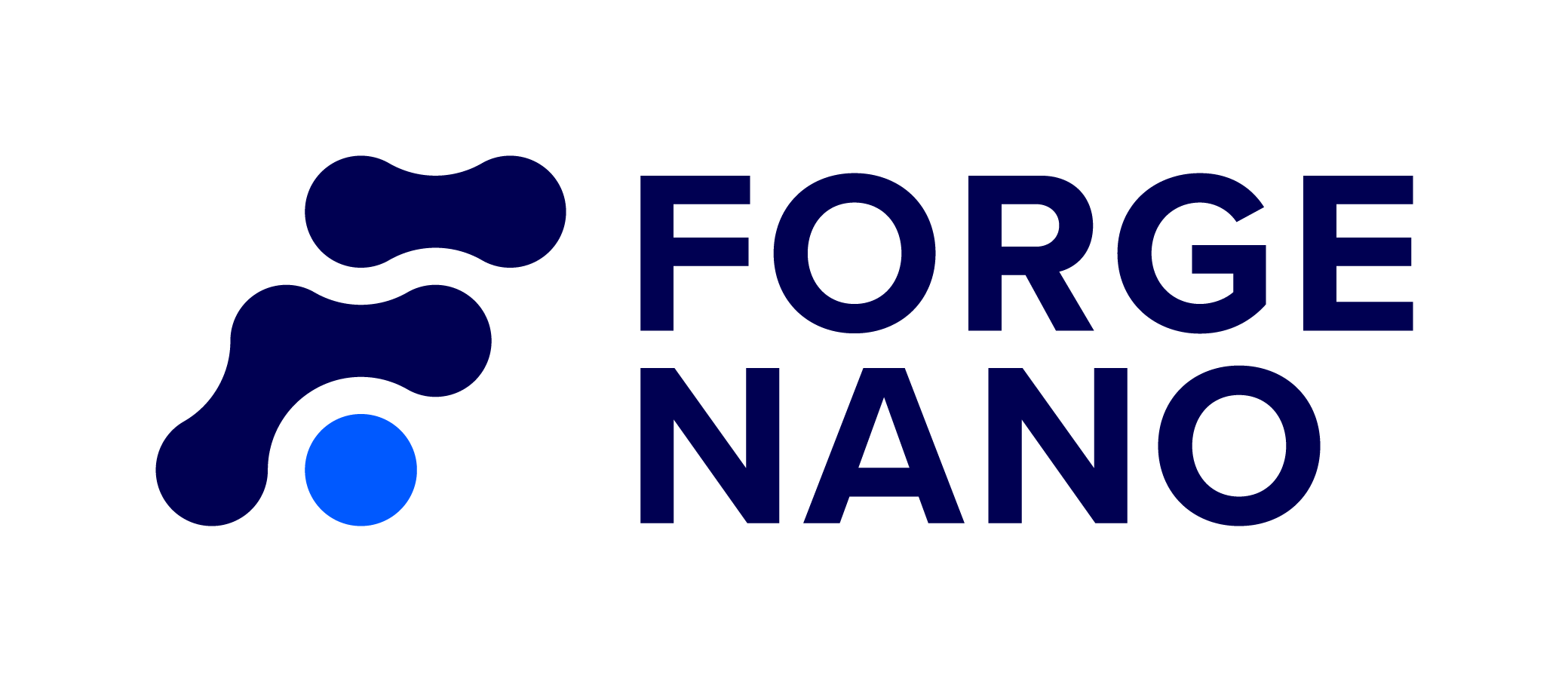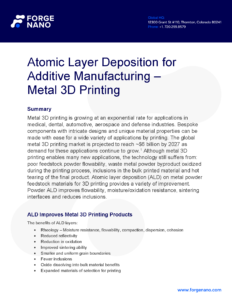3D PRINTING - METALS

Atomic Layer Deposition for Additive Manufacturing – Metal 3D Printing
Metal 3D printing is growing at an exponential rate for applications in medical, dental, automotive, aerospace and defense industries. Bespoke components with intricate designs and unique material properties can be made with ease for a wide variety of applications by printing. The global metal 3D printing market is projected to reach ~$6 billion by 2027 as demand for these applications continue to grow.1 Although metal 3D printing enables many new applications, the technology still suffers from: poor feedstock powder flowability, waste metal powder byproduct oxidized during the printing process, inclusions in the bulk printed material and hot tearing of the final product. Atomic layer deposition (ALD) on metal powder feedstock materials for 3D printing provides a variety of improvement. Powder ALD improves flowability, moisture/oxidation resistance, sintering interfaces and reduces inclusions.
ALD Improves Metal 3D Printing Products
The benefits of ALD layers:
- Rheology – Moisture resistance, flowability, compaction, dispersion, cohesion
- Reduced reflectivity
- Reduction in oxidation
- Improved sintering ability
- Smaller and uniform grain boundaries
- Fewer inclusions
- Oxide dissolving into bulk material benefits
- Expanded materials of selection for printing
ALD for Flowability
Variability in feedstock properties can lead to uneven layering of particles in a powder bed resulting in inconsistent bulk density, leading to lower tensile strength products and hot tearing of material. Flowability of feedstock powder impacts the final printed product. ALD can improve the flowability of powder without chemically changing the bulk particle. In a 2019 study, five TiO2 ALD layers on the particle surface were enough to quadruple the flowability of a partially crystalline material and to triple the flowability of an amorphous material, yet the coating process did not change the solid form of the materials and did not affect other critical characteristics related to the functionality of the materials.2
Image 1: Five cycles of TiO2 ALD performed on powders to quadruple or triple flowability.
ALD for Oxidation Reduction
Metal powders can undergo rapid oxidation during several phases of production which significantly reduces the quality of the final printed product. In powder bed fusion, specifically, bordering particles to the laser radius may be exposed to high heat without sintering which increases the native oxide thickness and hinders future sintering or reuse of powder substrate. With the ability to form dense, pinhole-free films, ALD significantly reduces oxidation of pure metals in high temperature environments. In one study, oxidation trials revealed that 20-nm-thick Al2O3 films deposited at a substrate temperature as low as 100°C suppress oxidative attack on pure copper and also showed excellent durability of adhesion strength.3 In a different study from Institute of Energy and Climate Research in Jülich, Germany, a ZrO2 ALD film protected pure nickel from oxidation in an extreme fuel cell environment.4 Adding ALD coatings to feedstock metal powder can significantly decrease oxidation thickness which will lead to more uniform sintering and less inclusions.
Image 2: Comparison of uncoated versus coated titanium powder in powder bed fusion metal 3D printing. Thick native oxides on uncoated powder create inclusions and large oxide fragments that impact sintering quality. Alternatively, using a highly dense and conformal ALD film minimizes further oxidation of the powder and improves overall sintering quality.
In a test performed by Forge Nano, Ti64 was oxidized in a thermogravimetric analysis (TGA) environment, where oxygen was dosed through the powder as the weight of the powder was studied. As the temperature rose, the powder mass increased as the titanium metal began to oxidize to TiO2. The uncoated titanium oxidized rapidly starting around 200oC. However, the ALD coated powder labeled “Mod 1-3” shows decreased oxidation at elevated temperatures or decreased oxidation at lower temperatures depending on the thickness of the ALD coating. In a following test, pristine and ALD coated titanium powder was oxidized at 450oC over five days while appearance was monitored. The uncoated oxidized titanium turns to a dark color after only 20 hours, while a certain thickness of alumina ALD labeled “3 ALD” maintains the unoxidized titanium color over 118 hours.
Image 3: Oxidation of pristine and ALD coated titanium powder in a TGA environment.
Image 4: Visual comparison of pristine and ALD coated titanium powder before and after oxidation.
ALD for Tuning of Sintering Properties
The sintering ability of powder can be influenced by selection of ALD coating to achieve the desired outcome based on application. A ceramic will raise the temperature necessary for sintering decrease sintering potential of boarding particles. For metal powders that contain more than one metal component, a thin ceramic ALD coating on the lower melting point metal can raise the sintering temperature to the level of the other metal powder, improving grain boundaries and eliminate hot tearing. For powders with poor sintering ability, ALD of an oxide resistant pure metal will aid sintering between particles, decrease inclusions, and prevent hot tearing. In a test performed by Forge Nano, laser powder bed fusion 3D printed metal with ALD coated feedstock powder resulted in higher uniformity grain structure due to smaller grain structures.
Image 5: Comparison of 3D printed titanium using uncoated versus ALD coated feedstock powder.
Image 6: Comparison of 3D printed aluminum using pristine versus ALD coated feedstock powder.
About Forge Nano
Forge Nano is a leading materials science company harnessing the power of Atomic Armor, the company’s proprietary ALD nanocoating technology, to accelerate manufacturing innovation, transform product performance and achieve a more sustainable future for a range of industries around the world. Atomic Armor produces superior coatings that can unlock a material’s performance at the atomic level and deliver custom solutions from small-scale R&D and laboratory work to large-scale, high-volume production lines. A range of materials can be enhanced through Atomic Armor, including batteries, medical devices, catalysts, propellants and 3D additives. Forge Nano has received major support and signed meaningful partnerships with Volkswagen, LG Technology Ventures, Mitsui Kinzoku, Air Liquide and Sumitomo Corporation of Americas, largely as a result of the company’s innovation in the Lithium-ion battery industry and successful track record of improving product performance and safety while reducing cost.
Forge Nano’s Capabilities
- >20 in-house ALD systems for coating of wafers, powders and objects
- Including research, pilot and commercial scale systems capable of processing anywhere from 1.0 g to 30,000 kg powder or extrudates per day
- Fast deposition times up to 30nm per minute for rapid Al2O3 ALD coating solutions
- The world’s most knowledgeable and experienced team for ALD onto a range of materials
- PhD scientists, certified Professional Engineers, career scientists
- 20+ years’ experience designing and building powder ALD systems
Working with Forge Nano
Forge Nano assists customers daily with both R&D and commercialization of ALD-enabled materials. For R&D, we offer research services for proofs of concept and also sell our R&D equipment globally. For commercialization, we offer joint development of products, production equipment and IP licensing.
References and Further Reading
1. “3D Printing Metal Market | Reports and Data: The Increasing Use of 3D Printing in the Automotive and Aerospace Sectors” NASDAQ OMX’s News Release Distribution Channel, 21 Sept. 2020. ProQuest Central
2. “Improving Powder Characteristics by Surface Modification Using Atomic Layer Deposition” Cosima Hirschberg, Nikolaj Sølvkær Jensen, Johan Boetker, Anders Østergaard Madsen, Tommi O. Kääriäinen, Marja-Leena Kääriäinen, Pekka Hoppu, Steven M. George, et Al, Organic Process Research & Development 2019 23 (11), 2362-2368
3. M.L. Chang, T.C. Cheng, M.C. Lin, H.C. Lin, M.J. Chen, Improvement of oxidation resistance of copper by atomic layer deposition, Applied Surface Science, Volume 258, Issue 24, 2012, Pages 10128-10134, ISSN 0169-4332, https://doi.org/10.1016/j.apsusc.2012.06.090
4. Thomas Keuter, Georg Mauer, Frank Vondahlen, Riza Iskandar, Norbert H. Menzler, Robert Vaßen, Atomic-layer-controlled deposition of TEMAZ/O2–ZrO2 oxidation resistance inner surface coatings for solid oxide fuel cells, Surface and Coatings Technology,Volume 288,2016,Pages 211-220,ISSN 0257-8972, https://doi.org/10.1016/j.surfcoat.2016.01.026

